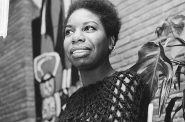Harry Potter and the Half-Blood Prince
Emma Watson and Rupert Grint in Harry Potter and the Half-Blood Prince. Hormones!
I am probably one of four people on the planet who have not read all the Harry Potter books. I read a few of them to my son several years ago, and we listened to one of them in the truck driving around Montana one summer. I read enough to realize that they were getting darker and more complicated as Harry got older and his life became richer with experience, and as he recognized the responsibility of his gift.
The latest one, The Half-Blood Prince, opened last week to jammed houses at midnight. It’ s the richest film yet, both in the visual images it presents and the complexity of the story it attempts to tell. The other films are kids’ movies by comparison — charming and funny, cute when the three principals were really young, a little darker when death came with the Death Eaters, but all of them were self contained movies with a beginning, middle, and a definite end. You can watch them if you haven’t read the books and enjoy yourself. If you know the book, you can fill in the valleys and move from peak moment to peak moment more easily. But the first five films managed to respect the complexity of the stories while honoring the necessary film structure. I don’t think The Half Blood Prince does that.
The three main characters in the story have known each other for the previous five years of school at Hogwarts, and the actors themselves have been together for eight years of making these films. They have literally grown up together. They started when they were 11 to 13 years old and now they are 20 or more. Imagine the changes in your thinking in those years in particular, let alone the size of your britches. As characters they are just now realizing that there may be more to friendship than comparing notes on your class in the dark arts, or trying to catch a rat that is really a person, or being chased by a werewolf that is actually your friend and teacher. Those are all real bonding experiences, but nothing beats a snog.
Then there is the wonderful assortment of characters that come and go as teachers at Hogwarts. The most influential of these is Albus Dumbledore. And this is Dumbledore’s film. After the last book was published, J. K. Rowling made the announcement that she had always thought of Dumbledore as being a homosexual. I thought it was a curious statement. Why not just let readers and audience think what they would? Why point them in a particular direction — unless it was to sell more books?
There is a wonderful moment at the very beginning of the film where the great Michael Gambon, playing Dumbledore, puts his arm around Harry in a protective manner. But the way Gambon moves his arm almost snakelike, and we see his fingers first, then the entire hand come around Harry’s arm, literally taking possession of young Harry, who stands smiling innocently, bravely, looking at a future that will be difficult but doable because of the help of this great and trustworthy man. The camera moves to follows the movement and comes in to rest upon the hand of Dumbledore. It is a chilling moment. It reveals the man and opens our imagination to a complicated, dangerous but courageous future. I don’t think it would have the resonance it has if Rowling had not made that particular statement.
The film is filled with beautiful visual images like that. Moment follows moment of very compelling cinematic work. The soundtrack as usual supports these images. I found myself sitting forward in my seat to catch every detail and thinking that of all the Harry Potter films, this would be one that I would have to see again. But by the end it is disappointing. There is no end, no dramatic conclusion. This film more than the others is very obviously only part of a whole, the conclusion of which we have to wait two years to see.
My son, who has read them all, tells me that the final battle at Hogwarts took five chapters in the book. It barely happens in the film. Dumbledore is killed while Harry hides beneath the stairs of the tower, but it is anti-climactic. The great man has stepped forward off the pages in the person of Michael Gambon, and most of us know that he must die, and then Snape … just … kills him. There is really no build to that moment, though it may be in part because the young actor who plays Malfoy brings not much more than a grimace and blond hair to the performance.
Alan Rickman is superb as Snape, but he is given very little time to purr out his lines. It’s barely a spoiler to say that Snape is the Half-Blood Prince of the title, because very little is made of the mystery of who the Half-Blood Prince is and why Harry has his Potions textbook. When Snape gives us the answer, there is almost a feeling of “So what?”
The most fun performance is Jim Broadbent as Professor Horace Slughorn as he teeters between being a smarmy spy and a true longing to help the Chosen One. He has aligned himself with evil but there is something helplessly unfortunate and almost accidental about this relationship.
There are many great ingredients here, but they don’t add up to a successful film. There is so much story that some of it has been wholly abandoned, more has been foreshortened, and most of it has been strung together with beautiful images that no longer relate to each other unless you know the story and can fill in the empty spaces from memory. Which, as I stated at the beginning, puts me at a bit of a loss.
Movies
-
Milwaukee Film Festival Returns in April
 Mar 27th, 2024 by Sophie Bolich
Mar 27th, 2024 by Sophie Bolich
-
Nina Simone’s Summer of Soul
 Nov 29th, 2022 by John Sieger
Nov 29th, 2022 by John Sieger
-
The Surprise Pick for Best Picture
 Mar 22nd, 2022 by Dominique Paul Noth
Mar 22nd, 2022 by Dominique Paul Noth

















